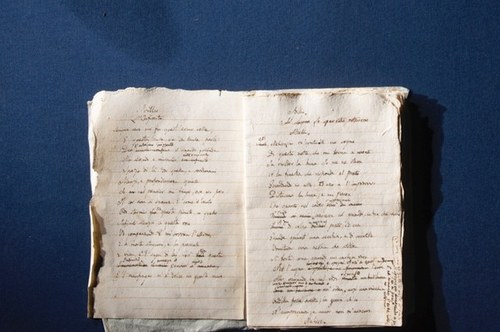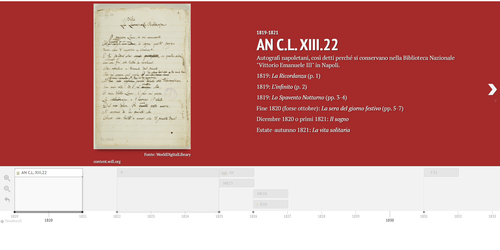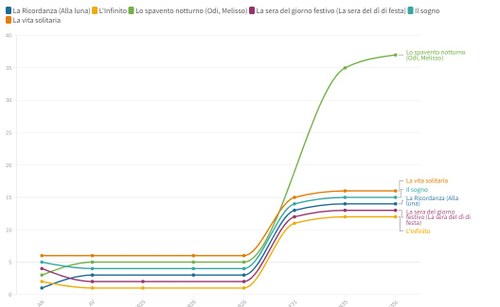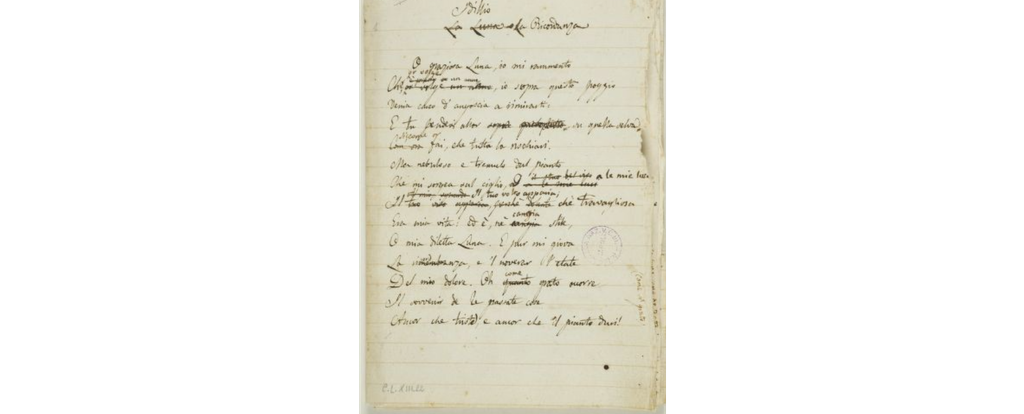Leopardi3D
The project is dedicated to the philological analysis of Leopardi's manuscripts seen in their three-dimensionality, studied both materially and metaphorically, in relation to the third dimension of the autograph ("z") constituted by the "time" factor. The first case study is the Neapolitan Notebook.

Idylls: from autographs to prints
The story of Leopardi's Idylls begins with the so-called "Neapolitan notebook" autographed by Giacomo Leopardi, a small lined notebook signed AN C.L. XIII.22 from the National Library of Naples, where it is kept. The visitor will be able to learn about the stories of the six components thanks to a new virtual narration enriched by multiple visualization tools. The story will take place on two levels: the first will follow the diachronic path up to the insertion of the Idylls within the system of Songs, another will frame the peculiar modality of composition within the notebook itself.
On this page you will find:
- Browse the Notebook: link to the site of the Library of Congress, where the digitization of all the pages of the Quaderno can be found;
- Timeline: a graph that allows you to view autographs and prints containing the Idylls over time;
- The path of the Idylls: a graph showing how the position of each Idyll varies from the first autograph to the last print;
- Stratigraphies and pens: a short video on the work of graphic processing that allows you to view the different pens and stratigraphies hidden in the text of the Idylls in the Neapolitan Notebook;
- Storytelling: a short illustrated narration on the three times of composition of the Idylls in the Neapolitan Notebook;
- The three times of the Idylls: an in-depth study taken from the Seminar "Papers, pens and inks" (Bologna, 2019), in which the composition of the Idylls is reconstructed and a particular three-dimensional acquisition technique called RTI is shown, which has been applied to the Infinite.

Timeline
The interactive timeline tool allows you to navigate in time through some fundamental stages of Leopardi's work. This interactive timeline created with Knightlab allows you to follow the evolution of Leopardi's idylls from the earliest known draft (AN) to the final draft of the text updated to the author's last will (N35c).
Discover the interactive visualization by clicking HERE!

The path of the Idyllis
The graph shows the path that the idylls make from the first known draft to the author's last will, passing through the various autographed and printed stages, allowing you to follow their order and movements within the nascent Canti.
Discover the interactive visualization by clicking HERE!
Stratigraphies and pens in the Idylls
With the help of post-production tools we discover the stratigraphies and the different feathers hidden in the texts of the Idylls. The case of "The night fright" shown in this video is an example because the highest number of interventions is deposited on this text: even five correctorial campaigns. The works were produced by the students of the Faculty of Cultural Heritage within the didactic laboratory "Computer Graphics 1", who at first worked on identifying the pens, distinguishing them with different colors and subsequently reconstructed the phases of composition of the text, eliminating corrections, deletions and overwriting for each layer and analytically revealing its evolution.
Storytelling: how the "Neapolitan Notebook" is built
The three times of the Idyllis
In this video, taken from the International Study Seminar "Papers, pens and inks" (Bologna 2019), the complete history of the formation of the Idylls in the Neapolitan Notebook is retraced and the three-dimensional acquisition technique called RTI, applied to the Infinite of Leopardi as an auxiliary tool of the philological study, which can help to emphasize grooves of corrections and stratigraphies for a more in-depth analysis of the textual composition.
